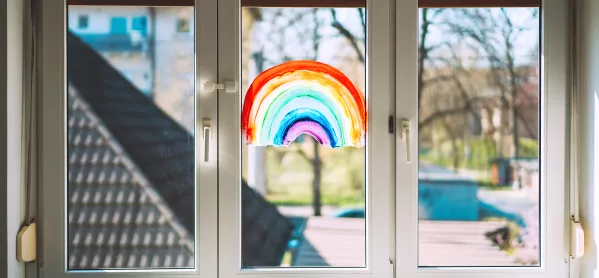- Home
- A day in the life: teaching key workers’ children
A day in the life: teaching key workers’ children

8am
It is the last week of the Easter holidays, but our school is still open. I arrive early to unlock the building, but the caretakers have got there first, so I get busy setting up the day’s creative activities and trying to hunt down that box of elastic bands that I know I have somewhere.
Planning feels very different when you have a mixed-age group and there are no goals or targets…
8.45am
Sonia’s mum is the first to drop off and she is struggling again. She is doing a great job working for the NHS, but leaving her seven-year-old with us is difficult. She reminds Sonia four times to wash her hands.
For a moment, I think she is going to change her mind and take Sonia back home and phone in sick. But she doesn’t.
9.15am
Time for Joe Wicks. Nice as he is, he has lost his charm a bit after all these weeks.
The younger students are now climbing backstage to see how the curtains work, while the older ones look judgementally at me as I jump up and down like a bunny rabbit.
Sam has the idea to suddenly start playing tag with Ben and Josh, so we have to explain social distancing again - although I’m still not convinced he understands.
The students then ask for Andy from CBeebies, who I have to say does less talking and has some interesting animal facts as well.
10am
As the students start their first session - making pop-up cards - it’s time for me to complete the new Department for Education registration form. It’s taking a while because every other teacher around the country is trying to log in to do the same thing at the same time, and besides, I am distracted watching Hamish trying to use a ruler to measure his pop-up card.
I ask if he has ever used a ruler before - maybe in maths?
He looks at me in shock that he can transfer the same ruler skills to making cards.
11.15am
Breaktime seems to be getting longer but, thank goodness, it’s still nice weather. We have found a lot of chalk and are encouraging students to draw on the floor or help to design a large rainbow on one of the outer walls of the sports hall.
I turn around to see Libby, who is 8, hugging her friend who seems upset.
And then, out of the corner of my eye, I spot the old lady in the house next to the school watching and shaking her head from her front porch.
Again, I try to explain to the pupils about social distancing.
The rainbow is going well until one of them sees a spider and gets freaked out, saying that it has bitten them. And now no one wants to join in.
What I thought would be a fun activity that might last an hour suddenly isn’t going so well…
12.50pm
Lunchtime can’t arrive fast enough.
To try to prevent too much work for the catering staff, we have moved to the connecting primary school, which means sitting on chairs made for eight-year-olds. We are also all spread out two metres apart, which is a very odd way to eat.
The kitchen staff are cooking enough food for 100 people, and I know that supplies are limited, so I feel too guilty to order only a salad. My diet has gone out of the window.
Sarah seems particularly down today; she is classed as a vulnerable child, so I know that there is a lot going on for her. I really want to have a quiet word, but social distancing is making it awkward.
Finally, I catch her eye and encourage her to go on a little walk with me. She has a bit of a cry as she explains what’s going on at home, and I feel even worse keeping my two-metre distance.
3pm
It’s started to rain, so we are inside watching a bit of TV.
The younger students want to watch Tom and Jerry. Thank goodness for YouTube, as I can quickly find a few episodes.
Tom is smoking a cigar and one of the 10-year-olds asks what it is. The next 10 minutes turn into a mini PSHE lesson.
Once the cigar discussion is over, the rain has stopped, so we head back outside to play some tennis. What that really means is hitting a tennis ball at a wall and hoping it doesn’t get stuck in the roof guttering.
After 20 minutes of this, I have run out of tennis balls and realise I will be writing one apologetic email to the caretakers.
4pm
Pick-up time. Parents are looking relieved and extremely tired as they thank me for my time. I feel like a fraud, knowing that what I have done is nothing in comparison to what they have been doing with their day.
But I put on a smile and tell them: “We’ll be right here again tomorrow.”
Ceri Stokes is assistant head (DSL) at Kimbolton School in Cambridgeshire. She tweets @CeriStokes
Keep reading for just £1 per month
You've reached your limit of free articles this month. Subscribe for £1 per month for three months and get:
- Unlimited access to all Tes magazine content
- Exclusive subscriber-only stories
- Award-winning email newsletters



